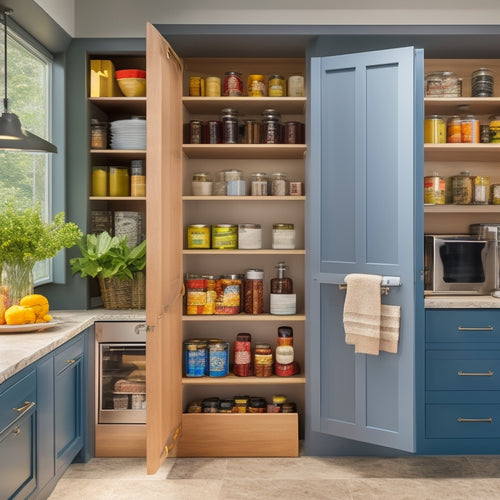
Survival Guide: Rainy Day Foods Handbook
Share
A rainy day survival plan is only as strong as its foundation - a well-stocked emergency food storage system. Don't assume you'll be able to scrounge up something edible when disaster strikes; a solid system guarantees you'll have a steady supply of nutritious food. But it's not just about stockpiling cans and dried goods; you need to know how to turn them into actual meals. And let's not forget the importance of shelter and preparation for various emergencies. When the rain starts pouring, you'll want to be prepared with more than just an umbrella - discover how to build a complete rainy day survival strategy that will keep you and your family safe and fed.
Key Takeaways
• Build a strategic emergency food storage system tailored to your family's needs, including nutrient-dense foods and calculated caloric requirements.
• Master simple recipes and tips from the Rainy Day Foods Handbook to turn stockpiled ingredients into nutritious meals.
• Prepare for various emergencies, such as natural disasters, economic downturns, and pandemics, by assembling emergency kits and identifying safe zones.
• Establish a well-stocked emergency food storage system as the foundation of your rainy day survival plan, ensuring a steady supply of nutritious food.
• Access valuable insights and guidance from the Rainy Day Foods Handbook to enhance your emergency preparedness and survival skills.
Building Emergency Food Storage
One critical element of emergency preparedness is constructing a detailed food storage system. This can be a challenging task without a clear understanding of the essential elements to include.
Stockpiling essentials is not just about hoarding cans of beans. It's about creating a well-rounded system that meets your family's unique needs.
Effective emergency planning involves identifying potential risks, calculating caloric needs, and selecting nutrient-dense foods that will remain edible during extended storage periods.
Don't fall into the trap of stockpiling random items. Instead, focus on building a strategic food storage system that will provide sustenance during times of crisis.
By doing so, you'll be better equipped to weather the storm and safeguard your family's well-being.
With the Rainy Day Foods Handbook, you'll gain valuable insights into building a detailed emergency food storage system that will give you peace of mind.
Mastering Survival Recipes and Tips
Having a well-stocked emergency food storage system is only half the battle; knowing how to prepare and utilize those stored ingredients in creative and nutritious ways is where the Rainy Day Foods Handbook really shines, offering a wealth of simple recipes and tips to help you survive and thrive during times of crisis.
Let's face it, a stash of long-lasting ingredients is only as good as the meals you can whip up with them. This handbook takes the guesswork out of emergency preparedness, providing you with the know-how to turn canned goods and dried legumes into satisfying, nutritious meals that'll keep you going when the going gets tough.
With the Rainy Day Foods Handbook, you'll be well-equipped to weather any storm, and actually enjoy the process.
Preparing for Various Emergencies
Catastrophic events, such as natural disasters, economic downturns, and pandemics, can strike at any moment, making it vital to be prepared for a wide range of emergencies.
Don't be caught off guard; instead, take proactive steps to secure your safety and well-being. Start by assembling emergency kits that include essential items like food, water, first aid supplies, and communication tools.
Shelter preparedness is also essential, so identify safe zones in your home and community, and consider investing in a portable shelter or tent.
Remember, preparation is key to survival. By taking these steps, you'll be better equipped to face whatever emergency comes your way.
Frequently Asked Questions
What Is the Average Shelf Life of Food Stored Using Rainy Day Foods Methods?
When properly stored, the average shelf life of food depends on factors like food rotation, preservation methods, and storage conditions, including temperature, which can range from 2-30 years, ensuring a safe and reliable emergency food supply.
Can I Customize the Handbook for My Family's Specific Dietary Needs?
When preparing for emergencies, it's important to think about personalized menus that cater to your family's specific dietary needs and restrictions, ensuring a tailored approach to emergency food storage that prioritizes health and safety.
Is the Handbook Suitable for Beginners With No Emergency Prep Experience?
Did you know that 60% of Americans are not prepared for a natural disaster? Fortunately, the Rainy Day Foods Handbook is designed for beginners, offering basic tips, beginner-friendly recipes, and emergency essentials for entry-level preparation, making it an excellent resource for those new to emergency prep.
Are the Recipes in the Handbook Suitable for Cooking in Outdoor Settings?
When cooking in outdoor settings, it's important to think about recipe modifications for best safety. The handbook's recipes can be adapted for outdoor cooking, but users should prioritize food safety guidelines to avoid contamination and foodborne illnesses.
Does the Handbook Cover Emergency Preparedness for Pets and Animals?
"Imagine a stormy night, your furry friends by your side, and wondering if they'll be safe and nourished. The handbook does cover pet safety and animal nutrition, providing valuable guidance on emergency preparedness for your beloved companions."
Related Posts
-

Stackable Kitchen Containers for Modular Systems
Stackable kitchen containers for modular systems change your cooking space by maximizing vertical storage and enhanci...
-

Wall-Mounted Racks for Kitchen Tool Storage
Wall-mounted racks are perfect for maximizing storage in your kitchen. By utilizing vertical space, you can free up u...
-

Affordable Sliding Pantry Drawer Solutions
If you're looking for affordable sliding pantry drawer solutions, you're in the right place. These drawers maximize s...


